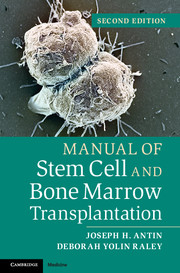Book contents
- Frontmatter
- Contents
- Acknowledgments
- Contributor
- 1 Rationale for transplantation
- 2 Types of transplantation
- 3 Human leukocyte antigen matching in allogeneic transplantation
- 4 Stem cell source
- 5 Pretransplant evaluation and counseling of patient and donor
- 6 Conditioning regimens
- 7 Stem cell infusion
- 8 ABO compatibility
- 9 Engraftment
- 10 Preventative care
- 11 Transplant-related complications
- 12 Overview of acute and chronic graft-versus-host disease
- 13 Acute graft-versus-host disease and staging
- 14 Graft-versus-host disease prophylactic regimens
- 15 Treatment guidelines for acute graft-versus-host disease
- 16 Chronic graft-versus-host disease
- 17 Engraftment syndrome
- 18 Infectious disease
- 19 Graft rejection and failure
- 20 Gastrointestinal complications
- 21 Oral health in stem cell transplantation
- 22 Pulmonary complications
- 23 Veno-occlusive disease
- 24 Special transfusion-related situations
- 25 Cardiovascular complications
- 26 Neurologic complications
- 27 Cystitis
- 28 Donor lymphocyte infusion
- 29 Transplantation: regulation and accreditation
- Index
- References
12 - Overview of acute and chronic graft-versus-host disease
Published online by Cambridge University Press: 05 November 2013
- Frontmatter
- Contents
- Acknowledgments
- Contributor
- 1 Rationale for transplantation
- 2 Types of transplantation
- 3 Human leukocyte antigen matching in allogeneic transplantation
- 4 Stem cell source
- 5 Pretransplant evaluation and counseling of patient and donor
- 6 Conditioning regimens
- 7 Stem cell infusion
- 8 ABO compatibility
- 9 Engraftment
- 10 Preventative care
- 11 Transplant-related complications
- 12 Overview of acute and chronic graft-versus-host disease
- 13 Acute graft-versus-host disease and staging
- 14 Graft-versus-host disease prophylactic regimens
- 15 Treatment guidelines for acute graft-versus-host disease
- 16 Chronic graft-versus-host disease
- 17 Engraftment syndrome
- 18 Infectious disease
- 19 Graft rejection and failure
- 20 Gastrointestinal complications
- 21 Oral health in stem cell transplantation
- 22 Pulmonary complications
- 23 Veno-occlusive disease
- 24 Special transfusion-related situations
- 25 Cardiovascular complications
- 26 Neurologic complications
- 27 Cystitis
- 28 Donor lymphocyte infusion
- 29 Transplantation: regulation and accreditation
- Index
- References
Summary
Overview
Graft-versus-host disease(GVHD) is one of the classical complications of allogeneic stem celltransplantation. It is dependent on the presence of histocompatibilitydifferences between the host and the donor. These can be minor antigens inthe case of matched transplantation or major histocompatibility complex(MHC) antigens if there is some human leukocyte antigen (HLA)incompatibility. Minor antigens are presented to the T cells presumably inthe same way that bacterial or viral antigens are presented. Thus, inessence, the graft is functioning as if there were a severe infection, andthe graft tries to eradicate antigens that are intrinsic to the host. Thisresults in the tissue damage that we clinically recognize as GVHD.
There are two main categoriesof GVHD, acute and chronic, each with two subcategories:
Acute GVHD
Classic acute GVHD.
Late-onset acute GVHD .
Chronic GVHD
Classic chronic GVHD.
Overlap GVHD, with features of both acute and chronic GVHD
Previously, acute GVHD (aGVHD)was arbitrarily assigned to all allogeneic manifestations that occurredbefore day 100, and cGVHD to those occurring at er day 100, but thisdistinction is no longer considered useful. It is now recognized that therecan be late-onset aGVHD (frequently but not exclusively afterreduced-intensity transplantation), and manifestations of cGVHD may occurbefore day 100.
- Type
- Chapter
- Information
- Manual of Stem Cell and Bone Marrow Transplantation , pp. 48 - 49Publisher: Cambridge University PressPrint publication year: 2013

